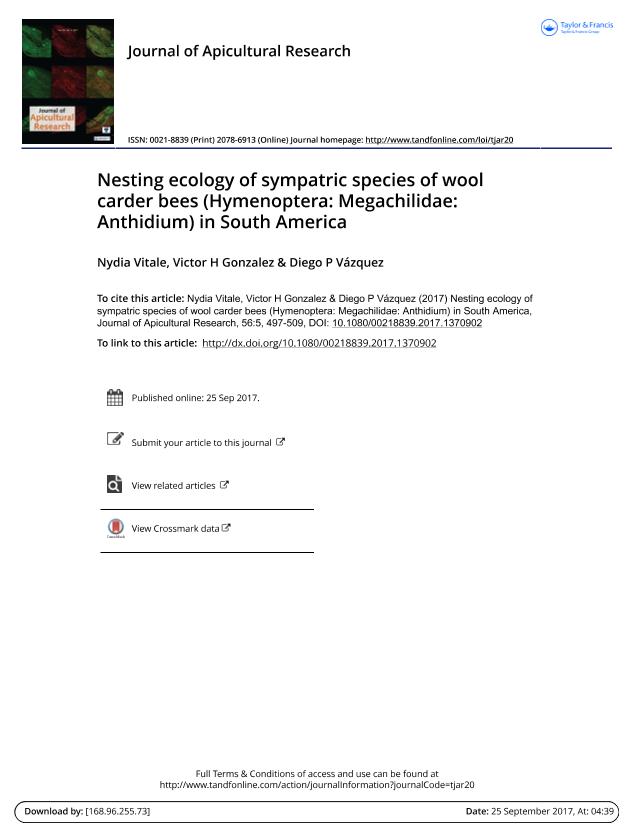Mostrar el registro sencillo del ítem
dc.contributor.author
Vitale, Nydia Luciana

dc.contributor.author
Gonzalez, Victor H.
dc.contributor.author
Vazquez, Diego P.

dc.date.available
2018-04-26T21:28:03Z
dc.date.issued
2017-09
dc.identifier.citation
Vitale, Nydia Luciana; Gonzalez, Victor H.; Vazquez, Diego P.; Nesting ecology of sympatric species of wool carder bees (Hymenoptera: Megachilidae: Anthidium) in South America; International Bee Research Association; Journal Of Apicultural Research; 56; 5; 9-2017; 497-509
dc.identifier.issn
0021-8839
dc.identifier.uri
http://hdl.handle.net/11336/43629
dc.description.abstract
Using a total of 14,043 trap-nests (potential nest for bees), we documented the nest architecture, host plants, seasonality,and associated organisms of the following six native species of Anthidium (Megachilidae: Anthidiini) from the CentralMonte Desert in Mendoza, Argentina: A. andinum Jo¨ rgensen; A. chubuti Cockerell; A. decaspilum Moure; A. friesei Cockerell;A. rubripes Friese; and A. vigintipunctatum Friese. Each species exhibited unique features in the arrangement of thefibers used to make their cells, and in the type of material used in the nest plug. Bees used a total of 41 plant species,but relied heavily on Prosopis flexuosa (Fabaceae) and Larrea spp. (Zygophyllaceae). Most bee species are univoltine andexhibited delayed emergence. The oil beetle Nemognatha sp. (Coleoptera: Meloidae) and the cuckoo wasp Chrysis striatulaBohart (Hymenoptera: Chrysididae) are recorded for the first time for Anthidium. Nemognatha sp. was the mostcommon brood parasite but C. striatula caused the highest brood mortality.
dc.format
application/pdf
dc.language.iso
eng
dc.publisher
International Bee Research Association

dc.rights
info:eu-repo/semantics/openAccess
dc.rights.uri
https://creativecommons.org/licenses/by-nc-sa/2.5/ar/
dc.subject
Nest Architecture
dc.subject
Solitary Bees;
dc.subject
Native Pollinators
dc.subject
Host-Plant Specialization
dc.subject
Nesting Behavior
dc.subject.classification
Otras Ciencias Biológicas

dc.subject.classification
Ciencias Biológicas

dc.subject.classification
CIENCIAS NATURALES Y EXACTAS

dc.title
Nesting ecology of sympatric species of wool carder bees (Hymenoptera: Megachilidae: Anthidium) in South America
dc.type
info:eu-repo/semantics/article
dc.type
info:ar-repo/semantics/artículo
dc.type
info:eu-repo/semantics/publishedVersion
dc.date.updated
2018-04-16T14:08:12Z
dc.journal.volume
56
dc.journal.number
5
dc.journal.pagination
497-509
dc.journal.pais
Reino Unido

dc.journal.ciudad
Bristol
dc.description.fil
Fil: Vitale, Nydia Luciana. Consejo Nacional de Investigaciones Científicas y Técnicas. Centro Científico Tecnológico Conicet - Mendoza. Instituto Argentino de Investigaciones de las Zonas Áridas. Provincia de Mendoza. Instituto Argentino de Investigaciones de las Zonas Áridas. Universidad Nacional de Cuyo. Instituto Argentino de Investigaciones de las Zonas Áridas; Argentina
dc.description.fil
Fil: Gonzalez, Victor H.. Kansas State University; Estados Unidos
dc.description.fil
Fil: Vazquez, Diego P.. Consejo Nacional de Investigaciones Científicas y Técnicas. Centro Científico Tecnológico Conicet - Mendoza. Instituto Argentino de Investigaciones de las Zonas Áridas. Provincia de Mendoza. Instituto Argentino de Investigaciones de las Zonas Áridas. Universidad Nacional de Cuyo. Instituto Argentino de Investigaciones de las Zonas Áridas; Argentina
dc.journal.title
Journal Of Apicultural Research

dc.relation.alternativeid
info:eu-repo/semantics/altIdentifier/doi/http://dx.doi.org/10.1080/00218839.2017.1370902
dc.relation.alternativeid
info:eu-repo/semantics/altIdentifier/url/https://www.tandfonline.com/doi/abs/10.1080/00218839.2017.1370902
Archivos asociados
